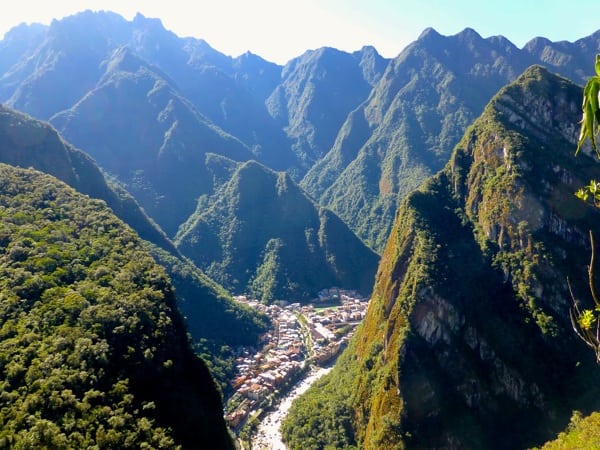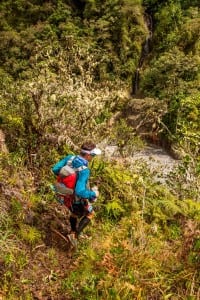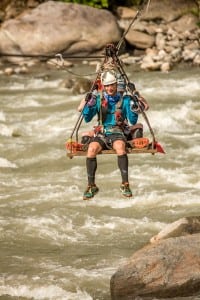Back in late May, I traveled to Peru to run a second-year event, the Jungle Ultra. I’d never been to Peru but the chance to run/hike in the Andes and then have fun at the race itself in the Amazon jungle was too good an opportunity to pass and looked like ideal preparation for Western States 100 and the Grand Slam of Ultrarunning (Western States 100, Vermont 100, Leadville 100 and Wasatch Front 100 in the same summer). Altitude, steep climbs, and heat, what more could the body need for running four hilly 100s?
The Andes
After flying into the historic capital of the Inca Empire, Cusco, the first week was my mountain week with hiking around classic Inca areas like the ruins at the world famous Machu Picchu. As expected, it was just as jaw-dropping as in the photos we’ve all seen and it was also packed with tourists. That morning started with long lines to get pre-dawn buses from Agua Calientes up to Machu Picchu, then another long line at the entrance followed by a slow conga up the steep steps into the ruins. As a runner, moving at the pace of overweight tourists at altitude didn’t appeal so I decided to turn on the GPS running watch and bag some Strava climbs, starting with the route up Machu Picchu Mountain. This mini peak towers above the site with a sharp one-mile climb straight up to 10,000 feet from under 8,500 feet. Once I got away from the crowds, it felt more like being in an Indiana Jones movie and I later found out that the discovery of Machu Picchu was part of the inspiration for that character. But I really needed a machete and whip to fit in, maybe switching the trail shoes for leather boots, too.

Agua Caliente from nearby trails. Photo: Ian Sharman
For any runners thinking of heading to Peru, bear in mind that if you choose the steepest and longest trails, you can always get away from the crowds. Plus, the Incas were legendary runners and made something like 60,000 miles of steep mountain steps through the Andes, so that’s a lot of real estate to explore. Even at Machu Picchu, I had around 45 minutes to myself at the summit of Machu Picchu Mountain to enjoy the rising sun playing with shadows over the ruins below. That solitude was magical and felt extra special because of the fact it was so simple to get away from the tour-group hordes.

Machu Picchu at dawn. Photo: Ian Sharman
The one regret I have is that I didn’t fully research the Inca paths since the famous Inca Trail to Machu Picchu is

Typical Inca paths. Photo: Ian Sharman
just one of many spectacular routes through the mountains and most don’t require annoying and limited permits or guides. It’s relatively easy to find climbs that make the Hardrock 100 course look flat and one can only assume the Incas were super-fit since the combination of altitude (Machu Picchu is around 8,000 feet while Cusco is closer to 11,000 feet) and stone steps often at a gradient over 50 percent is a killer on the legs and lungs. That was the only way in and out of their mountain cities so they used teams of relay runners to transfer messages quickly through the mountains. I suspect that they had some world class mountain runners if we could see them compete in today’s races.
I could easily have stayed in the mountains for the entire trip and it certainly fitted into my goals for the vacation, both for hill training and to see some of the most beautiful vistas I could hope for. It whetted my appetite for a return visit and created some memories that reinforced the fact I was in an emerging economy. My favorite of these was the shared taxi/minibus trip back to Cusco where a middle-aged local lady in traditional attire squeezed in next to me and proceeded to breastfeed six inches under my nose while screaming into her smartphone the entire journey. That just doesn’t happen back home and all I could do was chuckle inwardly about how absurd the situation was, a mixture of old world and new.
The Jungle
Much as the mountains were everything a trail runner could want and more, the initial reason for the trip was to run the Jungle Ultra, so I reluctantly left the pleasant temperatures and reasonably low level of bugs to head to the sweaty heat of the world’s most famous jungle. To cope with the expected mosquito attacks, I had 99% DEET spray which amused the other runners from Europe since they didn’t seem to think it was legal to sell such concentrated poison. We had plenty of time to chat on the six-hour rickety bus ride to Manu National Park.
The event itself was inspired by the Marathon des Sables and similar multi-day races, plus it’s part of a series of four races, the Jungle Ultra, Mountain Ultra (in Colorado), Desert Ultra (in Namibia), and Ice Ultra (in Sweden), all created by Beyond the Ultimate, a UK-based company. So the format is self-supported with the organizers providing only hot and cold water during the race, spread over five stages and approximately 143 miles (230 kilometers).
At the pre-race briefing, we were shown slides of the dangers we could expect to find, with an extremely long list of snakes, the potential to see a jaguar around the final campsite (if we’re lucky), caimans (think crocs), and numerous plants and trees with huge spikes. Virtually everything seemed to want to bite, stab, or otherwise puncture us and they didn’t even mention spiders. My favorite was the type of snake that will chase you so dropping the backpack was advised to distract it, although no ideas were given about how to get the pack back again!
Accommodation was in hammocks that we had to carry with us along with our food and emergency list of items. So most people had packs that weighed at least 20 pounds on day one. On paper it looked like an ideal training week for the Grand Slam and previous blog posts about the event in 2012 made it sound fun but not excessively hot or steep.

The start of the 2013 Jungle Ultra. Photo: Martin Paldan
Fewer than 30 runners started on day one with several locals aiming to bring the glory home for their country but mainly Brits and a contingent of Danish adventure racers. That adventure-racing background proved to be very helpful since the distances between aid stations were fairly approximate and stages were usually longer and always tougher than the organizers described. We started around 10,000 feet at the edge of the Andes and spent the first two days doing a lot of downhills (ideal for Western States).

Descending from the Andes. Photo: Martin Paldan
By stage three, we were really getting into classic jungle terrain with paths cut with machetes, leaving sharp bamboo stubs in the ground. The heat was difficult to bear in exposed sections since it combined with 100-percent humidity and there was no ice since we were so remote. Sweating was near useless for cooling the body and any water we poured on our heads was lukewarm. This is what we’d signed up for and day four was a beast of a stage that made us feel like explorers. Climbs were never very long, at perhaps 700 feet vertical at the most, but they were extremely steep and muddy, causing the calves to scream out in protest. The downhills were tougher since there was no good footing and most trees or vines were either spiky or completely covered in ants that were just waiting for a tasty hand to nibble on. I was glad I’d brought gloves for the potential for cold nights since I used them the whole time to save my hands from getting shredded or bitten.
Those first four days had been a tough training block and I could feel a slight twinge in my left knee, which had been an issue earlier in the year. In addition, the last stage was a 57-miler in blistering heat so I opted to save myself for the Grand Slam and take away a great experience of Peru without overly exhausting myself or causing my knee to flare up. It was the way I’d approached the whole of 2013 so far because the Grand Slam is a daunting task for me and I wanted to start it off as rested and fit as possible.

Ian and another competitor crossing a river. Photo: Martin Paldan
In hindsight, this was a very smart move because the final stage was incredibly testing. Even the eventual winner, Simon Grimstrup (Denmark), took something like 13 hours for the stage and he’s a very strong runner who dealt with the heat incredibly well given a lack of heat training. He finished in the dark during the start of a torrential storm and only the other Danes finished that night with the remaining runners having to be rescued from the course as the river they had to run up and down flooded. They tried to restart the next morning but the water levels remained dangerous so they were given finishes no matter how far they got through that last stage.
Overall, Peru was a fantastic experience and both the Andes and Amazon are special places that I’ll never forget. The mountains definitely appealed to me more, but it’s always worth trying new things and the jungle was certainly unlike anything I’ve dealt with before. The Jungle Ultra itself is also a tougher event than I gave it credit for and isn’t a suitable training week for Western States if done in its entirety. For trail runners, there are few places that are more enjoyable and spectacular to run in and I know I’ll be back to run through those mountains again, although maybe I’m not in as much of a rush to go back to the jungle.

Ian making friends with a local. Photo: Martin Paldan
